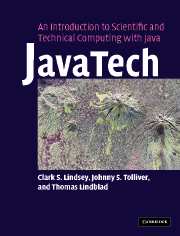Book contents
- Frontmatter
- Contents
- Preface
- Acknowledgements
- Part I Introduction to Java
- 1 Introduction
- 2 Language basics
- 3 Classes and objects in Java
- 4 More about objects in Java
- 5 Organizing Java files and other practicalities
- 6 Java graphics
- 7 Graphical User Interfaces
- 8 Threads
- 9 Java input/output
- 10 Java utilities
- 11 Image handling and processing
- 12 More techniques and tips
- Part II Java and the network
- Part III Out of the sandbox
- Appendix 1 Language elements
- Appendix 2 Operators
- Appendix 3 Java floating-point
- Index
- References
5 - Organizing Java files and other practicalities
Published online by Cambridge University Press: 08 January 2010
- Frontmatter
- Contents
- Preface
- Acknowledgements
- Part I Introduction to Java
- 1 Introduction
- 2 Language basics
- 3 Classes and objects in Java
- 4 More about objects in Java
- 5 Organizing Java files and other practicalities
- 6 Java graphics
- 7 Graphical User Interfaces
- 8 Threads
- 9 Java input/output
- 10 Java utilities
- 11 Image handling and processing
- 12 More techniques and tips
- Part II Java and the network
- Part III Out of the sandbox
- Appendix 1 Language elements
- Appendix 2 Operators
- Appendix 3 Java floating-point
- Index
- References
Summary
Introduction
In this chapter we look first at several topics related to the organization of Java files. In fact, a scheme for organizing Java files and classes comes built into the language. When a class is used, the name of the class includes, either explicitly or implicitly (via the import directive), its location in a particular package. The Java package resembles the code libraries of other languages and provides a name space that successfully avoids name collisions. In practice, a large class library will contain many packages – the J2SE 1.4 class library contains over 100 separate packages – arranged in some sensible order. A very small, single-purpose library might reside entirely in just one package.
In some of the examples in previous chapters the code included the public modifier. We finally explain in this chapter exactly what that modifier does. It and the other access modifiers determine what classes, methods and fields can be used by methods in other classes and subclasses, in the same and in other packages.
For faster downloading, you can pack your Java packages, classes, images, audio files and other program resources into a single file called a JAR (Java Archive) file. JAR files use the ZIP format and compression system (a variation of Lempel-Ziv) to hold files and to maintain internally a hierarchical directory system like that on disk. We show how to create JAR files and how to extract files from them.
- Type
- Chapter
- Information
- Publisher: Cambridge University PressPrint publication year: 2005



